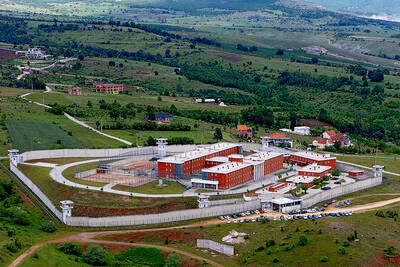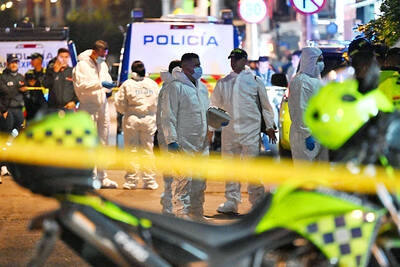Just over a week after a ceasefire with India was struck, Pakistan’s foreign minister is visiting his country’s largest arms supplier, China, with the performance of the weapons they supplied a matter of burning interest for analysts and governments alike.
The most striking claim from four days of fighting earlier this month was Islamabad’s contention its Chinese-supplied jets had shot down six Indian aircraft — including three French-made Rafale fighters — with some observers seeing this as a symbol of Beijing’s rising military might.
Experts who spoke to AFP cautioned that a lack of confirmed information and the limited scope of fighting made it difficult to draw solid conclusions about the Chinese equipment’s prowess.

Photo: AFP
Still, “this was a rare opportunity for the international community to gauge Chinese military hardware on the battlefield against Western [Indian] hardware,” Lyle Morris of the Asia Society Policy Institute said.
While China pours hundreds of billions of dollars into defense spending each year, it lags far behind the US as an arms exporter.
China’s drones are used in counterterrorism operations, and its weapons have been deployed by Saudi Arabia in Yemen and against rebel forces in African countries, Stockholm International Peace Research Institute (SIPRI) senior researcher Siemon Wezeman said.
“But this is the first time since the 1980s that a state has used large numbers of Chinese weapons of many types in action against another state,” Wezeman said, referencing the Iran-Iraq war when they were used on both sides.
Pakistan accounts for about 63 percent of China’s arms exports, SIPRI said.
In the recent fighting, Pakistan used the J10-C Vigorous Dragon and JF-17 Thunder planes, armed with air-to-air missiles.
It was the first time the J10-C has been used in active combat, Yun Sun of the Stimson Center said.
Islamabad’s air defenses also used Chinese kit — including the HQ-9P long-range surface-to-air missile system — and deployed Chinese radar, as well as armed and reconnaissance drones.
“This was the first sustained fight where the bulk of Pakistan’s forces used Chinese weapons and, basically, relied on them as their primary option,” said Bilal Khan, founder of the Toronto-based Quwa Defence News & Analysis Group.
India has not officially confirmed any of its aircraft were lost, although a senior security source told AFP three jets had crashed on home soil without giving the make or cause.
Rafale maker Dassault has also not commented.
The Rafale is considered one of Europe’s most high-tech jets, while the J10-C “is not even China’s most advanced,” said James Char from Singapore’s Nanyang Technological University.
However, if Pakistan’s claims are true, “this should not be surprising ... considering that the Rafale is a multirole fighter, whereas the J-10C was built for aerial combat and is also equipped with a stronger radar,” Char said.
The Chinese air defense systems however “do not appear to have been as effective as the Pakistan Air Force would have hoped,” Khan said, after India said it had neutralized one near the eastern border city of Lahore.
If true, that “would be a bigger success and more than balance the loss of some aircraft in the process,” Wezeman said.
In the days after the dogfight reports, J10-C maker Chengdu Aircraft Company’s stock soared more than 40 percent.
“We most likely will see more orders going to Chinese contractors,” Sun said.
However, “it will take time and significant reorientation by Chinese arms manufacturers for the country to be a big arms exporter,” Jennifer Kavanagh of the US think tank Defense Priorities said.
She added that China “cannot mass-produce certain key inputs, including aircraft engines.”
Wezeman said he thought the stock markets “overreacted,” as “we still have to see how well all the weapons used worked and if it really means much.”
Even if more data emerge, the conflict still does not reveal much about the Chinese military’s own capabilities, the analysts said.
China’s own systems and weapons are much more advanced than what it exports. And while having high-tech hardware is important, “much more important is how those weapons are used,” Kavanagh said.
Brian Hart of CSIS said he would caution against “reading too much” into recent developments.
“I don’t think you can make direct comparisons to how these Chinese-made systems would fare in different environments against more advanced adversaries like the United States,” he said.
“Since the number of data points is small and since we don’t know much about the proficiency and training of the personnel on either side, it is hard to draw definitive conclusions,” he said.

By 2027, Denmark would relocate its foreign convicts to a prison in Kosovo under a 200-million-euro (US$228.6 million) agreement that has raised concerns among non-governmental organizations (NGOs) and residents, but which could serve as a model for the rest of the EU. The agreement, reached in 2022 and ratified by Kosovar lawmakers last year, provides for the reception of up to 300 foreign prisoners sentenced in Denmark. They must not have been convicted of terrorism or war crimes, or have a mental condition or terminal disease. Once their sentence is completed in Kosovan, they would be deported to their home country. In

Brazil, the world’s largest Roman Catholic country, saw its Catholic population decline further in 2022, while evangelical Christians and those with no religion continued to rise, census data released on Friday by the Brazilian Institute of Geography and Statistics (IBGE) showed. The census indicated that Brazil had 100.2 million Roman Catholics in 2022, accounting for 56.7 percent of the population, down from 65.1 percent or 105.4 million recorded in the 2010 census. Meanwhile, the share of evangelical Christians rose to 26.9 percent last year, up from 21.6 percent in 2010, adding 12 million followers to reach 47.4 million — the highest figure

LOST CONTACT: The mission carried payloads from Japan, the US and Taiwan’s National Central University, including a deep space radiation probe, ispace said Japanese company ispace said its uncrewed moon lander likely crashed onto the moon’s surface during its lunar touchdown attempt yesterday, marking another failure two years after its unsuccessful inaugural mission. Tokyo-based ispace had hoped to join US firms Intuitive Machines and Firefly Aerospace as companies that have accomplished commercial landings amid a global race for the moon, which includes state-run missions from China and India. A successful mission would have made ispace the first company outside the US to achieve a moon landing. Resilience, ispace’s second lunar lander, could not decelerate fast enough as it approached the moon, and the company has

‘THE RED LINE’: Colombian President Gustavo Petro promised a thorough probe into the attack on the senator, who had announced his presidential bid in March Colombian Senator Miguel Uribe Turbay, a possible candidate in the country’s presidential election next year, was shot and wounded at a campaign rally in Bogota on Saturday, authorities said. His conservative Democratic Center party released a statement calling it “an unacceptable act of violence.” The attack took place in a park in the Fontibon neighborhood when armed assailants shot him from behind, said the right-wing Democratic Center, which was the party of former Colombian president Alvaro Uribe. The men are not related. Images circulating on social media showed Uribe Turbay, 39, covered in blood being held by several people. The Santa Fe Foundation